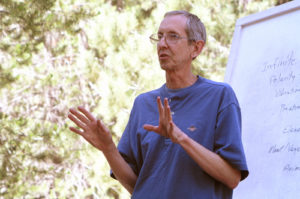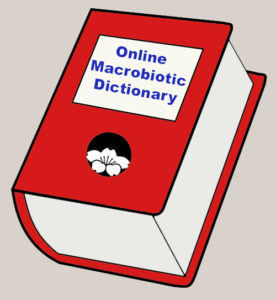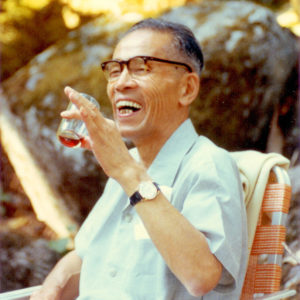
Completed Entries
Calcium is a yin alkaline-forming mineral that is basic to good nutrition. It builds strong bones and keeps them healthy and is vital in blood clotting, muscles contracting, activity of some enzymes, and the heart beating regularly. Calcium is available in most foods but is particularly high in milk and dairy products. The macrobiotic view is that cow’s milk is mainly for baby cows; milk and other dairy products are only consumed occasionally as a pleasure food, if at all. Vegetal sources of calcium include sesame and other seeds, sea vegetables like dulse, broccoli, nuts, soy products, and leafy green vegetables such as kale, collards, and parsley.
In macrobiotic thinking, complex carbohydrates are the preferred source of energy as carbohydrates turn into glucose (sugar) in the body. They provide more energy and fewer waste products than animal protein or fat. Carbohydrates are the most yang of the three major nutrients; fats are the most yin and proteins are between the two. Digestion of carbohydrates begins in the mouth. In addition to providing energy, especially energy to the brain, carbohydrates help control blood glucose, insulin, and fat metabolism.
Carbohydrates are a large group of organic compounds including sugars, starches, and fiber that occur in grains, vegetables, fruits, and milk products. They contain carbon and hydrogen and oxygen in the same ratio as water (2:1) and are broken down in the body to release energy. Carbohydrates are grouped into two main categories: simple and complex. Simple carbohydrates contain one or two sugars linked together, provide a quick rise in blood sugar (glucose), and turn to fat in excess. Examples include fruit sugar (fructose), corn sugar (dextrose), and refined sugar cane (sucrose). Complex carbohydrates contain three or more sugars linked together, take longer to raise blood sugar, and provide more nutrients and fiber. Examples include whole grains, beans, and vegetables. A macrobiotic dietary approach is high in complex carbohydrates (about 68 percent) and low in simple carbohydrates (about 5 percent). A typical modern American diet is higher in simple carbohydrates (about 26 percent) than complex ones (about 20 percent). Complex carbohydrates provide more energy and fewer waste products than animal protein or fat.
Ground meat from a fresh carp mixed with enough flour to make a paste-like mixture and applied to the chest for the specific purpose of reducing very high fevers, especially in cases of pneumonia. It is never used for mild fevers.
See Cautionary note.
Heated castor oil used as a compress for diverticular pain or as a follow-up to a ginger compress for body pain.
See Cautionary note.
Acknowledgment that actions are at least partially determined by prior actions. The aim is to discover and alter the underlying cause to yield a better result (effect) in the future.
See also Change.
Water from boiled cedar leaves in which one immerses only the hands or feet to help reduce pain or swelling in those areas.
See Cautionary note.
Moving or directed outward from the center (opposed to centripetal). “Centrifugal yin produces: cold (slackening of the components’ movement); dilation; expansion; lightness (thus, the tendency to go upward); enlargement; tall (in the vertical sense), thin, forms.” Philosophy of Oriental Medicine, 23.
Another way to describe yin-yang. The interplay between the centrifugal and centripetal forces generates energy.
Directed toward the center (opposed to centrifugal). “Centripetal yang produces the following phenomena: heat (for example, the activity of molecules); constriction; density; heaviness (thus, the tendency to go downward); flattened, low, horizontal forms.” Philosophy of Oriental Medicine, 23.
In several older macrobiotic books, the term “cereals” or “cereal grains” is used instead of “whole grains.” It does not mean packaged processed breakfast cereals.
Something that occurs differently in the future than if no action is taken in the present. There are four types of change: stepped, linear, spiralic, and cyclic. “In the stepped pattern there are no changes for a time, and then there is a sudden change. In the linear pattern, some changes happen every day in a certain proportion; a graph will be closer to a straight line or curve, but not the zigzag line of a stepped change…Another path for change is the spiralic way of change. There are two aspects of spiralic change. One is centrifugal and the other is centripetal…The last pattern of change is a cyclic one. These changes are manifested in natural rhythmic cycles. Our daily activity, hunger, bowel movement, sugar metabolism, etc., are changing by daily or hourly cycles. Then there are the monthly cycles, like menstruation or ovulation.” Kaleidoscope, 246-247.
See Everything Changes.
Flat wheat bread, a staple of India.
Ground black ashes used as food, drink, or application for therapeutic reasons.
See Cautionary note.
Charcoaled hair: Charcoaled hair swallowed with a little water or made into tea to help stop bleeding.
Charcoaled kombu: Charcoaled kombu mixed with roasted salt for tooth pain, added to kuzu bancha tea for sore throat pain, or mixed with lotus root powder to help control asthma.
Charcoaled mulberry bark: Charcoaled mulberry bark mixed with sesame oil to help promote hair growth.
Charcoaled umeboshi: Charcoaled umeboshi added to kuzu bancha tea with ginger to help improve elimination problems, added to a taro plaster to help remove toxins more quickly, or made into tea to help reduce fever.
Japanese custard made with egg and ginkgo nut.
Water from boiled chestnut leaves used as a full bath for skin disorders.
See Cautionary note.
See Animal foods. If chicken is eaten, the macrobiotic recommendation is to obtain the best quality free-range chicken available and to prepare it using macrobiotic principles. Chicken that is chemically produced or treated is best avoided.
For infants, breast-feeding is preferred and kokkoh (grain milk) is recommended if breast-feeding is not possible. Animal milk is not recommended and no animal products until age fifteen or sixteen is preferred, so the immune system has ample time to fully form. Other suggestions include wearing loose cotton clothing, eating miso soup with mochi, whole grains, (no animal foods), and vegetables, and using the right amount of sea salt. Condition is indicated by bowel movement analysis.
Cold cooked rice with vegetables sprinkled on top.
Small dried fish used for soup stock, tempura, nitsuke, vegetable pancakes.
Unseasoned stew with tofu, served with lemon sauce.
Juice from any green vegetable leaves used as a massage on any area of yang skin disease such as dry eczema.
See Cautionary note.
Any ground up green leaves (daikon greens are considered most effective) and unbleached white flour made into a paste-like consistency and placed on the forehead for high fevers or anywhere there is inflammation. For fevers, chlorophyll plasters are a suitable yet weaker substitute for tofu or albi plasters.
See Cautionary note.
A disease that lasts three or more months and for the most part cannot be prevented by vaccines or cured by medication. The macrobiotic view is that chronic diseases can be remedied by the study and practice of macrobiotic principles.
Small dried fish from Chuba (now Iwate prefecture), Japan. Silver color.
Ohsawa’s term for the unifying principle of yin-yang, providing a method for making decisions and pointing the way toward awareness of one’s connection with Oneness (Infinity).
Complaining is expressing dissatisfaction or finding fault with something, often in a whining way. Ohsawa encouraged people to have a joyful attitude with no complaining. The goal is to live with Unconditional Love—the ability to embrace everything and to turn every antagonism into complementary agreement. This ability is extremely difficult for human beings and very few, if any, are able to accomplish this attitude. Still, keeping this goal in mind can be helpful in dealing with complaints.
The reality that all apparent antagonisms complete each other and thus are not separate. It is the definitive characteristic of the relative world of incessant change as the antagonisms compete with each other.
See Order of the Universe.
“A compress refers to a pad of folded cloth (linen or cotton), moistened with hot or cold liquid, and applied to the skin to help relieve discomfort by providing heat, cold, pressure, etc. Compresses are used to help bring circulation to a particular area of the body.” Natural Healing for Head to Toe, 176.
See Cautionary note.
Arame compress: Hot arame water used as a compress for improving circulation or to relieve rheumatism pain.
Bancha tea eye compress: Warm bancha tea mixed with salt and used to swab the eye and as a compress in cases of mild eye pain.
Castor oil compress: Heated castor oil used as a compress for diverticular pain or as a follow-up to a ginger compress for body pain.
Daikon ginger compress: Boiled daikon greens with ginger juice added and used as a compress to help improve circulation, relieve itching, or reduce swelling or pain.
Ginger compress: Hot water with ginger juice added and used as a compress for any kind of pain and for strengthening the kidneys and removing excesses and blockages. Saké or rubbing alcohol is added to help severe coughing and salt is added for severe nerve pain. The ginger compress is one of the most-used macrobiotic remedies.
Hot towel compress: Hot water used as a compress to ease cramps or on the forehead to temporarily relieve feeling faint.
Oil compress: Unheated cooking oil used as compress for burns.
Rice bran compress: Boiled rice bran water used as a compress for itchy skin or allergies.
Salt water compress: Cold salted water used as a compress for extensive burns.
Ume extract compress: Cold water, ume extract, and salt used as a compress for non-poisonous snakebites.
Warm towel compress: Warm water used as a compress on the head and/or the back of the neck for insomnia.
Willow leaves compress: Boiled willow leaves water used as a compress for extensive burns.
Wood ash compress: Hot water with fireplace ashes at the bottom used as a compress for skin diseases.
A condiment is a seasoning added at the table in small amounts for flavor. They allow individuals to make adjustments during the meal based on personal taste and health condition. Popular condiments in a typical American diet are ketchup, mayonnaise, mustard, and hot sauce. A macrobiotic practitioner avoids or minimizes these foods depending on his or her condition and purpose, especially if chemicals or artificial seasonings are listed in the ingredients. Commonly used condiments in a macrobiotic practice include gomashio (sesame salt), roasted nuts and seeds, toasted nori, sesame seaweed powder, tekka (made from miso and various root vegetables), furikake (specifically powdered dried fish and nori), umeboshi, and shiso leaf powder. Most of these condiments are Japanese in origin as is macrobiotic philosophy itself. Efforts are being made to Westernize macrobiotic practice.
The state of one’s health. The macrobiotic view is that the normal condition of all beings is to be healthy. Sickness is seen as a condition caused by being too far out of balance.
Ohsawa defined seven conditions of real health as: no fatigue, good appetite, deep and good sleep, good memory, good humor, clarity in thinking and doing, and living with a sense of absolute justice. He said the first three conditions are worth five points each. The fourth, fifth, and sixth are worth ten points each. The seventh condition is worth fifty-five points. “In all, there are a total of one hundred points. Those who score more than forty points at first are in relatively good health. Should you total sixty points in three months, it will be a great success for you.” Zen Macrobiotics, 34. (The following conditions are adapted from Zen Macrobiotics, 35-43.)
- No Fatigue: One should not feel fatigued or catch cold. A really healthy person does not shy away from difficulties and is adventurous. Fatigue is the real foundation of all diseases.
- Good Appetite: The ability to eat the simplest food like whole grains and fresh vegetables with pleasure and gratitude, and joyful satisfaction during sexual experiences.
- Deep and Good Sleep: The ability to fall asleep within three or four minutes after lying down, to sleep without dreams or speaking, and to awaken fully energized at a predetermined time.
- Good Memory: The foundation of human behavior; helps one make sound decisions based on remembered experience, especially remembering people who have been kind.
- Good Humor: A person who is cheerful and pleasant under all circumstances, even during difficulties. Such a person distributes deep gratitude and thankfulness to all people, including perceived enemies. The healthy person never gets angry.
- Clarity in Thinking and Doing: The ability to think, judge, and act with promptness and clarity to meet any challenge or necessity. Such a person has the ability to establish order everywhere.
- The Mood of Justice: A full understanding of the Order of the Universe and the intention or goal to grasp the deepest meaning in life. A person who has the mood of justice lives by the biological law: From one grain, ten thousand grains—returning more than received.
The state of being aware of one’s own existence, senses, thoughts, surroundings, and so on. Individual consciousness is a manifestation of universal consciousness. Like all things in the universe, consciousness develops in an orderly way. All beings are part of the same infinite and thus are connected in this way. One’s consciousness creates one’s reality, which depends on one’s thinking, which in turn depends on the foods one eats, the books one reads, the conversations one has, the qualities one is born with, and so on.
Buddhist concept that the human soul inhabits the infinite world of Oneness before duality while at the same time the human body inhabits the visible world of apparent opposites. “Understanding, God, instinct, intuition, large self, Daiva, or Nirvana are nothing but a partial expression of Perfect Consciousness.” Unique Principle, 41.
See Order of the Universe.
The physical condition and characteristics with which one is born. No two people have the same constitution—everyone is unique.
This principle added by Herman Aihara seems to contradict the principle that everything changes. Things that one begins often end before one would like. Continuing something promised or planned for a longer period of time reflects the highest consciousness that does not change.
See Truth.
The tendency to contract as in becoming smaller or shrinking; used in macrobiotics to describe the yang side of the yin-yang pair.
Water from a freshly boiled crab used for poison oak or ivy rash.
See Cautionary note.
A great yearning or desire for a certain food or drink—another example of a signal that the body is out of balance in some way. If the food is not beneficial to one’s health, a substitution to a more healthy food is recommended. For example, if the craving is for cow’s milk, one might try rice, almond, or soy milk.
The origin and manner of the bringing into existence of all things. “One, the Infinite, beginning without beginning, produces two poles—yin and yang—eternal antagonists that are strongly attracted to one another because they are antagonistic. Wherever they meet, a desperate struggle ensues and, from this encounter, a third antagonist is born. It is in this manner that all phenomena (visible and invisible) are created. All consequent creations are necessarily more and more complicated and differentiated.” Cancer and the Philosophy of the Far East, 34.
A great yearning or desire for a certain food or drink—another example of a signal that the body is out of balance in some way. If the food is not beneficial to one’s health, a substitution to a more healthy food is recommended. For example, if the craving is for cow’s milk, one might try rice, almond, or soy milk.
The desire to learn about life, to have a big appetite or dream, to make the boring interesting, and to be open to new ideas. Ohsawa also encouraged people to figure out the answers to questions by themselves. Learning to think for oneself is one goal of macrobiotic practice.
Projected Entries
Cabbage
Calcification, pathological
Cancer
Carcinogens
Cardiac
Carotene
Carp soup (koi-koku)
Carrots
Cartesian dichotomy
Cast-iron
Cataracts
Cauliflower
Celery
Cell membrane
Cells, body
Centre Ignoramus
Cereal Grains
Cerebral hemorrhage
Cerebral sclerosis
Charak Samhita
Cheese
Chelation
Chemical additives
Chemotherapy
Chestnuts
Chewing
Chickpeas
Chico-San, Inc.
Chinese medicine
Chishima, Dr. Kikuo
Chlorophyll hipbath
Chocolate
Cholesterol
Chopsticks (hashi)
Churashi sushi
Chylomicrons
Climate effects
Code of Manu
Coffee
Coffee, Ohsawa (yannoh)
Colbin, Annemarie
Cold medications
Cold-pressed
Colostrum
Common cold
Community
Compas magazine
Confucius
Congestion
Constipation
Cooking
Cooking methods
Corn
Coronary heart disease
Cough, whooping
Coughs
Couscous
Cracked wheat
Crackers
Cramps
Crime
Criticism
Cuisine, macrobiotic
Cultural and Spiritual Olympics
Cushing’s syndrome
Cutting styles
Cyanide poisoning
Cystine
Questions or Comments?




